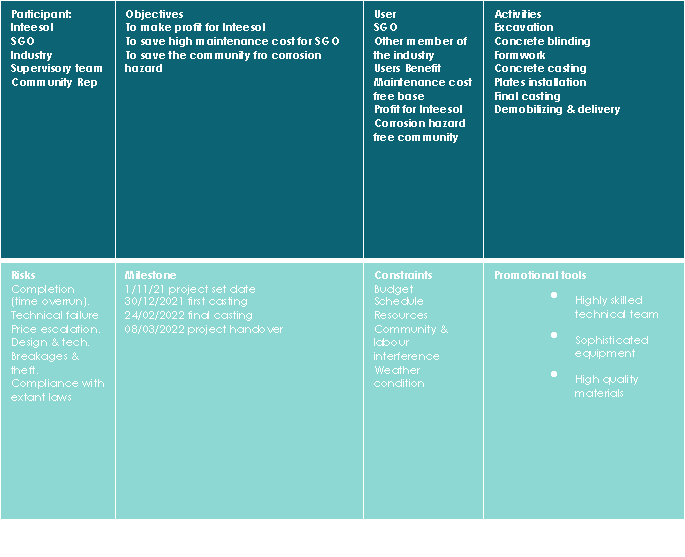Project Management Assignment: Personal Experience On The Live Project
Question
Task:
Rationale
The practice of Project Management requires working on your own initiative, collaborating with others and learning from experience. The Portfolio is an opportunity to combine theory with practice and draw upon your practical experience of undertaking a real project to demonstrate your critical awareness of project management knowledge, to evaluate the range of techniques you have used and to demonstrate your learning. The Portfolio also provides an opportunity to reflect on your project management learning so far, to compare your newly acquired knowledge, understanding and skills with those required in your current or future professional role, and to develop plans to close any gaps identified.
The project management assignment requires to create a Portfolio that demonstrates the development of your knowledge and understanding of project management principles and practices.
An Individual Critical Review (ICR) of your experience on the live project and critical self-reflection on your own personal development over the period of the unit demonstrating the knowledge and skills you have developed. The expected word count for this component is 1,500 words +/- 10%.
Answer
Individual Critical Review
The experience of the group project as explored within this project management assignment for the 'construction of a concrete base for low-pressure compressor' has been very interesting and enriching for all participants of the project. This project has helped us in understanding how the stakeholders need to be differentiated for effective segmentation of the market. I have realised the importance of accountability of the project participants to the different stakeholders. Cost-saving and resource-optimized operations, maximizing profit and reputation, fast clearance of stakeholders' dues, compliance with the best practices in the industry, adherence to social obligation, and regulatory compliance have emerged as the primary conditions of meeting project objectives(Del Giudiceet al.,2017). The project was designed very strategically with clear aims and objectives. After identifying the stakeholders and the project team's responsibility to them, the team explained the requirements based on the market and the population for whom the project is being performed. The requirement is followed by the vision and mission statement which guides the team in driving towards a well-guided path. The objectives of the project were too highly customer-centric. Offering all possible benefits to the stakeholders was the primary objective, which in turn, led to the secondary objective of profit generation.
Identifying the scope of the project was very critical in the execution plan. The scope is not static in this case. It circles around the design, the PBS and WBS, construction of the designed structure, Budget Analysis and Resource Planning and Sponsorship. After clear identification and description of the scope, the team went on to gather necessary resources and evaluate the environmental factors that might influence the progress of the project. Collection of the legal and safety clearance certificate was a part of this stage. The second major leap of focus in the project was made towards marketing and sales. Situation Analysis, identification of different objectives, strategies, tactics, actions and control were the focal parts of the marketing and sales strategy(Del Giudiceet al., 2017). The team focused on a comparative analysis of cost between the metal-based and concrete based LP compression in an area dominated by salty water. Bulk purchase of raw ingredients, and inspecting the delivery helped in meeting the objective that was saving the cost of Starling Global Oil and controlling the progress of the project. The product description emphasised the stronger and more durable product with a lack of maintenance requirements and long-lasting utility. Social media marketing through Facebook and Twitter helped in creating a brand image, increasing market size, measuring the degree of success and consumer satisfaction with little cost. The advertisement strategy involved social media advertisement, mail advertisement, and purchased online Ads to reach the maximum possible number of customers.
We announced the agreement of the project through our dedicated social media platform for this project after discussion and consent from all members. It helped in the fastest possible communication to a large variety of stakeholders in the project with little expense and instant review or ratings. After the agreement, the cost analysis was prepared with the help of all members of the group. The key items considered while the analysis is Excavation, Levelling and Compaction, Backfilling, Cement Supply by Company, Cement Supply by Contractor, Reinforcement Supply by Contractor, Curing, Cube testing, Formwork, PVC/Timber Chamber, and Anchor Bolt. This detailed analysis of cost helped in determining the budget and profit margin after the final production. The cash flow analysis indicated to potential revenue of 1.972.764.99 in NAIRA. Team members engaged actively in preparing the tables and charts of cash flow analysis, which gave the process a flawless outcome. After the Budget, the project team considered the site and operation management. The components in this section included the project site, stakeholders, project promotion, human resources, financial resources and risk management under the project breakdown. Each of the members contributed to preparing this blueprint and draft of the breakdown. With the help of the suggestions from the team members, scheduling the task became easier(Sartor & Beamish, 2018). The structure of work breakdown including the project site management, stakeholders’ communication, project promotion, human resource management and managing external participants was finalized after proper communication and solution of queries from the group members.
We utilized the GANTT chart for preparing the project schedule which helped in aligning all the necessary elements of the project to an integrated conceptual base. The chart clearly illustrated the different tasks, their categories and the person responsible or assigned for the same. It involved provisions of periodic meetings for all participants in all departments. The project scheduling part was also carried out with minute considerations and care from each of the participants of the project. The project was scheduled from 1.11.2021 to 8.3.2022. Starting from the setting of the project date, to cost and budget calculation, project presentation, risk assessment, starting excavation, receipt to a final evaluation of the project, each deadline was outlined clearly to avoid any confusion in the process(Sartor & Beamish, 2018). The design for the project management was very simple with the single authority of the CEO and a few hierarchies for Engineers, SURV, mason and ironworkers and carpenters. Finance, risk, marketing, human resource, site and operation had one manager each to look after the proper execution of the tasks. This well-dissected structure of the project helped in maintaining the deadlines without increasing the cost of operation and management. It also helped in retaining workers’ and managers’ consent throughout the project, thus, avoiding conflicts.
The project members unanimously followed five key steps in risk assessment for the project. These are – identification of the hazard, identifying the effect on different stakeholders, evaluation of the risks and deciding on precautions, documentation, and review. The four Ts model of Tolerating, treating, Terminating and Transferring risks worked appropriately in the analysis of risk impact. We divided the hazards under six key possibilities and numbered all of the possibilities based on their states before and after measures. All of the possibilities of hazards showed improvement and less potential after applying the necessary measurement. Only the delay in logistics showed fewer efficacies in handling even after trying to reduce the risk. This metrical assessment of risks helped in a clear description of the possibilities to reduce or manage them(Watsonet al., 2018). The team prepared a project canvas that further summarized all of the discussed details for getting the optimized view of the project at a glance.
Self Reflection on Personal Development
The participation in this project helped in my personal and professional growth from myriad aspects. Starting from the initial plan, I realized the importance of clear communication in managing projects successfully. Later I came to understand the importance of a thorough analysis and gradation of all necessary activities based on importance and timeline. This knowledge will not only help me in providing the best service to the professional domain but also reflect on my lifestyle management. Again, the application of the Gantt chart helped me in realizing the importance of clear responsibility and compliance to guidelines besides the deadline in managing projects. Charts and models make the process of project management easier. I can apply the learning from these models and the preparation of charts in my practical professional fields for improving productivity. The group engagement made me learn several other teamwork skills during the project(Watsonet al., 2018). I have become more attentive than before to others' words and opinions before stating my own regarding any decision in a group project. I have learnt to communicate in professional ways and constructively explain distinct viewpoints. This skill is not achievable from reading or external observation of the project. Only direct engagement to the project could deliver the benefits of enhancing my professional and personal skills as it has done.
Besides the theoretical considerations of project management, I have undergone several practical procedures in carrying out the project work. Preparing the charts, tables and illustrations for management, work allocation, follow-up and budget will help me in organizing projects effectively in my professional domains. Time-management skill is one of the best benefits I have acquired from this experience. I have also realized the importance of thriving for excellence before running behind profit in any project to make the best outcome from it. Satisfaction of the stakeholders has been the key focus in the mission, vision and objectives of this project. Here, I came to know about the importance of stakeholders including both internal and external ones, and not only the customers. Stakeholders also include the employees or members of the project team(Remi, 2017). Hence, satisfying the stakeholders involves more than a mere project success or quality-assured delivery of products. Management plays a key role in keeping the team organized, motivated and integrated. Integration helps in the effective exchange of information across the departments of the project that helped in preventing miscommunication or false interpretation of data. Following a common goal is not always easy in a diversified group-project environment. I have participated in regular meetings with all departments of the project. This participation helped me in collaborative decision-making that solves many problems in the process of project completion. Utilizing the project management techniques will help in my ad professional development immensely in future.
Part II
I have prepared the chart of identifying stakeholders under the broad heading of the project requirement. In this chart, four key aspects have been explained in nutshell. The minimal effort, the need for keeping informed, the importance of keeping the stakeholders satisfied and the key players in the project market are the four areas of consideration I have used here(Appendix A). This division has been made on the previous statements of vision and mission for the project. Both of these statements focus on stakeholders' satisfaction at large. Here, stakeholders' satisfaction is not only for customers but also for the suppliers, investors, workers and all possible sections of the society, who will experience the direct and indirect impact of the project(Remi, 2017). Hence, it is mandatory to consider the legal and regulatory compliance for sustainability while carrying out the project. The table on stakeholders' identification, thus, identifies community representatives, industry representatives, and the governments on whom minimal effort will be adequate. The supervisory team and the internal management are the main stakeholders who need to be continuously informed. Staff, supervisors and labours need to be satisfied with the managerial decision and the internal operations of the project.
I have also contributed to developing the marketing and sales strategy (Appendix B). This strategy has been visualized in a table format with six key considerations for success. These considerations include situation analysis, strategy, action, objectives, tactics and control. Differentiating these strategic steps helped the project in getting a clear concept of the objective and mission or vision of the project. Preparation of the chart helped me in realizing the small and often unidentifiable drawbacks in a project plan that might lead to futile attempts of marketing. The group members have also helped with their valuable inputs in the making of this table. These key criteria of a successful marketing strategy are extremely effective in the digital marketing medium(Stan & Puranam, 2016). As the project team was mainly interested in digital marketing through social media and direct messaging and mailing to potential consumers, the analysis of the situation and use of tactics to attract more users of these platforms helped the project in achieving its desired outcome largely. Inspection of material received from loading and delivery point is one such tactic that helped in resource management and optimization within the given timeline. Thus, the whole table aided the development and meeting of the roadmap.
I have actively participated in the preparation of the project breakdown structure during the project. Though my breakdown analysis was not finalized, the final breakdown included some key points of my idea of the project (Appendix C). The Stakeholders' identification, Human Resource Management, Scheduling with Gnatt chart and sustainability, and Project Evaluation are my direct contribution of mine in this illustration. Breaking down the project structure helps the team members and leaders further in differentiating between the various aspects and requirements of the project and plan accordingly. This approach helps in reducing frills and waste of other resources. Human resource focus, and the marketing and advertising focus, for example, help in the cost-effective execution of the plan within the designed roadmap of the project. In the project Breakdown Structure (Appendix D), I have contributed to the Task scheduling part after adequate discussion and exchange of opinions among the team members. The schedule is very clear and concise based on the probability of time required for each task in the project. For instance, while excavation has been given only three days, providing and fixing the hardcore has been given fourteen days considering all possible hazards that might come in the way.
I have participated in the development of the roadmap directly. The roadmap consists of all the key nodes towards the completion of the project (Appendix E). The project date setting took place on 1st November 2021. On the 3rd of the same month, the cost calculation and meeting with the finance department tool place. Then the team presented the project to the Sterling Global Oil company for contract finalizing. On 16/11 of the same year, the project team prepared the risk assessment on which I have contributed actively. The excavation began on the 18th of the same month. The project team received the first instalment of payment on the second of December 2021. This was the first step towards the success of the project. Receiving the second and third instalments has been scheduled on the 25th of December, 2021 and on the 17th of January, 2022. The following instalments are yet to be received by the team.
I have prepared the Human resource chart of the project resource plan (Appendix F). The chart has the CEO at the top of the hierarchy and the CEO is then followed by the managers of different departments.The departmentsinvolve project manager, finance manager, risk manager, logistic and procurement manager, human resource manager, and marketing manager. The project organizational structure is not too hierarchical and thus allows enough flexibility and liberty for the managers to make the best decisions for their departments. However, the team makes sure to meet about the performance and the daily updates on the project's advancement to integrate the process adequately and avoid the risk of misguided directions, thereby avoiding waste of resources(Stan & Puranam, 2016).
The Project canvas (Appendix G) is the bird's eye view of the whole project and the decisions taken for its successful completion. The canvas shows the extent of flexibility adopted by the team in carrying out the project. This table consists of nine key headers – the participants, the objectives, the users, activities, deliverable proposal, risks, milestones, constraints, and promotional tools. Each of these headings provides a clear concept about the complete plan for the project along with the tentative period of completion with small milestones and flexible promotion for scalability in the face of increased demand under different market dynamics (Stan & Puranam, 2016). The canvas again reminds us about stakeholders' satisfaction as the key to the project's success even before calculating the possible revenue. However, the complete guidance offered by Project Canvas helped all the participants in a quick recapitulation of the goals and deadlines whenever necessary.
Part III
Continuous Professional Development Plan
This project has helped me immensely in improving my project management skills. Though I have been a part of all the plans and decisions, it did not provide me complete scope to explore my capabilities as a solo manager as it was a group project. To improve my capabilities of project management I will follow a cyclic development plan as discussed below.
Plan: Planning with clearly defined short-term, mid-term and long-term goals is the primary task to improve my managerial skills aligned with projects (Takam & Park, 2017). Planning would include the basic resource measurement and requirements to get the primary idea about the project’s cost and effectiveness.
Do: After the initial planning, I would go for the small-term goals to fulfil in short steps. I would try to avoid any hurried decisions for avoiding risk in the mid-term and long-term goals. I would set up the objectives of the plan before proceeding with the small-term goal.
Record: This part is very helpful in improving skills by self-analysis of mistakes. Logging all the activities planned in the developmental phase is the main task during this phase. Logging would also include the incidents and circumstances that necessitated the review of the managerial decision and action on the floor of the project management task (Takam & Park, 2017). Multiple tools for recording different events and my response to those will find a place in the tables and charts dedicated to the different kinds of actions. Conflict management template, stakeholders' consent template, workers' disagreement and negotiation template are some examples of tools to be utilized in the recording of events.
Reflection: This is probably the most important part of the complete managerial role. In this part, I shall closely evaluate and analyse all of the incidents and actions were taken by me to find out the drawbacks in my thought process while handling and analysing the situation on the spot. I would incorporate my experience and feedback from different stakeholders about the effectiveness of the solution I offered in that scenario. In this stage, continuous development and sharing of experience are imperative.
Plan: After effective self-evaluation and analysis based on the recorded details about my performance, I would start the plan afresh to suit the different environments of project management and give the best possible guidance to my project team. I would also incorporate the learning and experience I gathered from the previous sessions of project management in this new effective plan.
The complete plan will include the review of the current governance practice, goals and action planning, implementation of institutional good governance, regular monitoring and benchmarking of the performance. The focus will remain on improving the benchmark standards and achieving higher success every day compared to my past success or performance. Active engagement in sharing information with the project teams and all kinds of stakeholders will help in the learning and development of my managerial skills (Takam & Park, 2017). I shall also keep notes of learning in a dedicated journal format to incorporate the references in different decision-making situations for an easy solution to conflicts and common queries among stakeholders.
References
Ang, S., Benischke, M., & Hooi, A. 2018. Frequency of international expansion through high control market expansion modes and interlocked directorships. Journal Of World Business, 53(4), 493-503. doi: 10.1016/j.jwb.2018.02.003
Del Giudice, M., Arslan, A., Scuotto, V., & Caputo, F. 2017. Influences of cognitive dimensions on the collaborative entry mode choice of small-and medium-sized enterprises. International Marketing Review.
Davis, E., Newcomer, K., Tinoco, J., & D'Allesandro, D. 2017. Mutual Organizational Sustainability: Organizational Interdependence in the New Public Service. Academy Of Management Proceedings, 2012(1), 15014
Jean, D., & Lohmann, G. 2016. Revisiting the airline business model spectrum: The influence of post global financial crisis and airline mergers in the US (20112013). Research In Transportation Business & Management, 21, 76-83. Giesler, M., & Thompson, C. J. 2016. A tutorial in consumer research: Process theorization in cultural consumer research. Project management assignment Journal of Consumer Research, 43(4), 497-508.
Goo, W., Choi, Y., & Choi, W. 2019. Coworkers' organizational citizenship behaviors and employees' work attitudes: The moderating roles of perceptions of organizational politics and task interdependence. Journal Of Management & Organization, 1-25. doi: 10.1017/jmo.2019.26
Holtbrügge, D., & Berning, S. C. 2018. Market entry strategies and performance of Chinese firms in Germany: The moderating effect of home government support. Management International Review, 58(1), 147-170.
Lojacono, G., Misani, N., & Tallman, S. 2017. Offshoring, local market entry, and the strategic context of cross-border alliances: The impact on the governance mode. International Business Review, 26(3), 435-447.
Remi Alapo. 2017. Organizational Power Politics and Leadership Experiences on the View and Use of Power in Organizations. Management Studies, 6(1). doi: 10.17265/2328-2185/2018.01.003
Sartor, M. A., & Beamish, P. W. 2018. Host market government corruption and the equity-based foreign entry strategies of multinational enterprises. Journal of International Business Studies, 49(3), 346-370.
Sent, E. M., & Kroese, A. L. 2020. Commemorating Geert Hofstede, a pioneer in the study of culture and institutions. Journal of Institutional Economics, 1-13. Shafiq, A., Johnson, P. F., Klassen, R. D., & Awaysheh, A. 2017. Exploring the implications of supply risk on sustainability performance. International Journal of Operations & Production Management.
Song, H., Turson, R., Ganguly, A., & Yu, K. 2017. Evaluating the effects of supply chain quality management on food firms' performance. International Journal of Operations & Production Management.
Stan, M., & Puranam, P. 2016. Organizational adaptation to interdependence shifts: The role of integrator structures. Strategic Management Journal, 38(5), 1041-1061. doi: 10.1002/smj.2546
Swanson, E. T. (2020). Measuring the effects of Federal Reserve forward guidance and asset purchases on financial markets. Journal of Monetary Economics. Szobiová, E. 2017. Creativity in Organizational Environment. Acta Technologica Dubnicae, 5(2), 69-79.
Takam, M., & Park, B. 2018. Entry Strategy of Korean Construction SMEs in the African Market. INTERNATIONAL BUSINESS REVIEW, 19(3), 57. doi: 10.21739/ibr.2015.09.19.3.57 Watson IV, G. F., Weaven, S., Perkins, H., Sardana, D., & Palmatier, R. W. 2018. International market entry strategies: Relational, digital, and hybrid approaches. Journal of International Marketing, 26(1), 30-60.
Yoder, S., Visich, J., & Rustambekov, E. 2016. Lessons learned from international expansion failures and successes. Business Horizons, 59(2), 233-243. doi: 10.1016/j.bushor.2015.11.008.
Appendix A
Stakeholders’ Identification
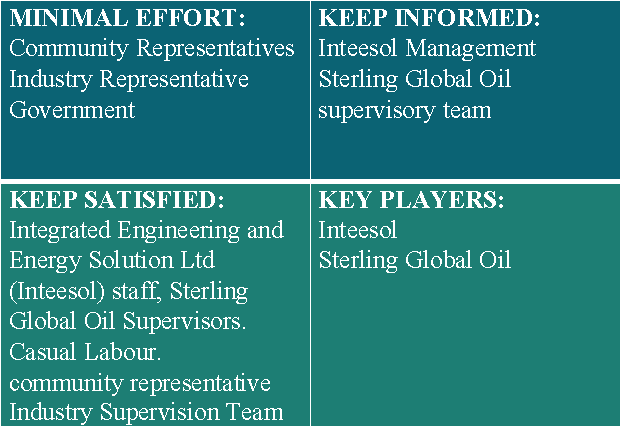
Appendix B
Marketing and Sales Strategy
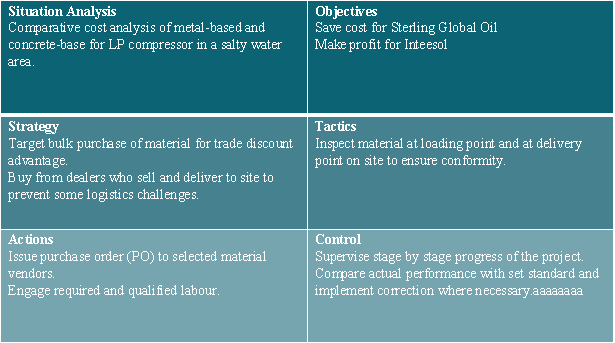
Appendix C
PBS
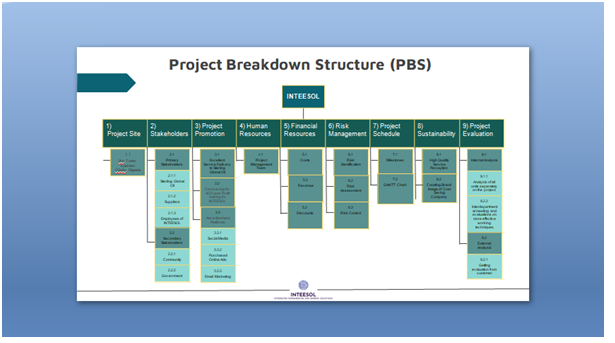
Appendix D
Tasks Scheduling
- Excavation (3 day)
- Levelling & compaction (10 day)
- Backfilling (3 day)
- Provide & Fix Hardcore (14 day)
- Provide & Place Cement Concrete Mixer (3 day x3)
- Reinforcement (2 day)
- Provide & Place Cement Concrete Mixer (3 day)
- Curing (7 day)
- Cube Testing (7 day)
- Formwork
- PVC/Timber Chamber (7 day)
- Anchor Bolt (1 day)
- Putting of Pockets (7day)
- Install Plates (7 day)
- Provide & Place Cement Concrete Mixer (1 day)
Demobilizing and Cleaning up (7 day)
Appendix E
Roadmap
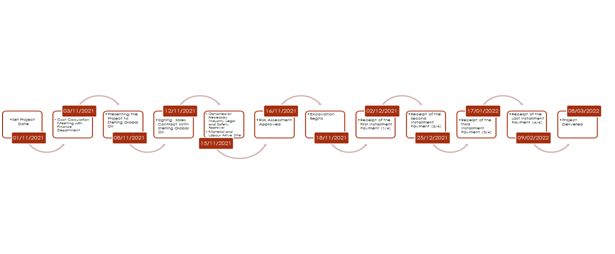
Appendix F
Human Resource Chart
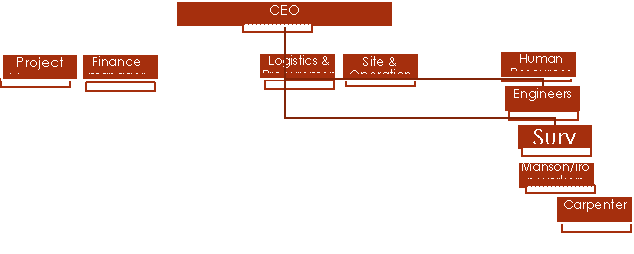
Appendix G
Project Canvas
